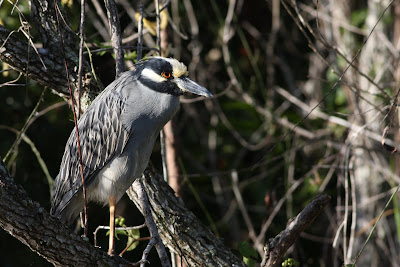Photos by various members of the Such family.

The Real McCoy - a non-sweaty Sanderling
This blog post summarizes our running exploits in the extremely flat and balmy state of Florida. Our trip commenced on January 25th with little planning or forethought thanks to a business conference that our dad was to attend in Jupiter (the city, not the planet). The rest of the family tagged along, adding an additional week and turning it into a “vacation,” though our dad insists it was more like an expedition. Unsurprisingly, Joel and I relished in sampling different habitats with a bird-centered agenda.
Slash Pine Flatwoods
Date: January 26
Location: Jonathan Dickinson State Park, Martin County

An easy 4.5 miles on sandy backcountry forest trails, this run was our first introduction to the hot and humid world of running in Florida. We logged an incredible 18 species (well, incredible based on past standards), sixteen (!) of which were new SWSA birds. Highlights were a calling Red-shouldered Hawk, great looks at a Pileated Woodpecker, and Masai’s much-belated lifer Palm Warbler. We also got Florida’s only endemic bird, Florida Scrub-Jay, though not as a SWSA bird.

Florida Scrub-Jay
Atlantic Coast Beach
Date: January 27
Location: Juno Beach Area, Palm Beach County
This morning we had another new experience…running barefoot on the beach. Welch and I had originally intended to only run three or four miles, but we ended up running nearly seven miles. Maybe it was the ocean breeze. Again logging 18 species, but this time of the completely different beach suite, we bagged 13 new Sweaty Sanderling species. Highlights were four species of shorebirds and five species of gull (six if you count terns). All of the Floridians that managed to brave the 55°F “cold snap” were all bundled up in multiple down jackets, and completely shocked to see two teenagers racing down the beach, frolicking in the shallows, both clad in nothing more than a pair of split shorts. One couple went so far as to inquire whether or not we belonged to the Polar Bear Club. We continued running, shaking our heads in confusion.

Ruddy Turnstone
Northern Everglades and Cypress Swamp
Date: January 29
Location: Loxahatchee National Wildlife Refuge, Palm Beach County

After a morning of devoted birding, Welch and I managed to find time for a quick four-mile run on the Marsh Trail. Slogging through the incredible heat and humidity was tough, but well worth it. We managed to produce an incredible 30 species, seventeen of which were new for our SWSA lists. Highlights were Glossy Ibis (a lifer earlier that day), Sora, Purple Gallinule, Caspian Tern, and Yellow-bellied Sapsucker. Before our run, we also found a couple of Limpkins and Snail Kites (both lifers).

Snail Kite
Slash Pine Flatwoods and Freshwater Wetland
Date: January 31
Location: Pinelands and Anhinga Trails--Everglades National Park, Miami-Dade County

A couple of quick runs on trails in Everglades National Park produced 16 species, four of which were new SWSA species (Pine Warbler, Wood Stork, Green Heron, and Black-crowned Night-Heron).
Ocean Channel in Florida Keys
Date: February 3
Location: Long Key Channel, Monroe County
This is actually a view from a kayak off of Grassy Key, but you get the picture . . . water and sky!
On this four-mile slog from Conch Key to Long Key through the most oppressive humidity and heat imaginable, we only managed to produce six species, with one new Sweaty Sanderling species . . . the truly magnificent Magnificent Frigatebird. Oh yeah, and we weren’t running on water, nor risking our necks on the highway, but were on the old railroad bed converted into a pedestrian trail.
Freshwater Canal and Everglades
Date: February 4
Location: Shark Valley--Everglades National Park, Miami-Dade County


We spent the evening of February 3rd and the morning of February 4th at the Shark Valley area of Everglades National Park. It was the perfect place for a nice run along a canal loaded with birds and alligators! We saw 21 species of birds on our run, with four being new SWSA birds – Yellow-crowned Night-Heron, Great Horned Owl, Limpkin, and White-eyed Vireo.
Salt Water Estuary along Gulf of Mexico
Date: February 6
Location: J.N. “Ding” Darling National Wildlife Refuge, Lee County

Our four mile run on the Wildlife Drive at the legendary J.N. “Ding” Darling National Wildlife Refuge on Sanibel Island just off of Fort Myers produced 30+ species, of which 9 where new SWSA species. I say “30+,” because I forgot to record the second half of the checklist, due to my own infinite forethought and wisdom (or would that be stupidity?). Highlights from the run were large numbers of Roseate Spoonbills, an assortment of Semipalmated and Piping Plovers, a few Dunlin, a couple of Pileated Woodpeckers, and a racoon family in the parking lot.

Juvenile Black-crowned Night-Heron

Defecating Osprey
Gulf of Mexico Beach
Date: February 7
Location: Alison Hagerup Beach Park, Captiva Island, Lee County
The day before our departure from Florida, we ran on the beach at the end of Captiva Island (one island farther out than Sanibel). When we birded the area earlier that morning, we recorded 19 species, including Masai’s lifer Parasitic Jaeger (that Welch didn’t see because he was distracted by seashells). On our run, however, we only managed to find twelve of the aforementioned species, of which three were new SWSA species – Black Skimmer, Royal Tern, and Sandwich Tern.

Royal Tern
So, we’re back home now and new SWSA birds are harder to come by. The night we arrived home had me dashing down the front steps in -15°F temperatures and slogging through a foot of snow in flip-flops. The heat and humidity are now just a hazy memory.
--
2011 SWSA Totals
Species=113
Miles Run=145











No comments:
Post a Comment